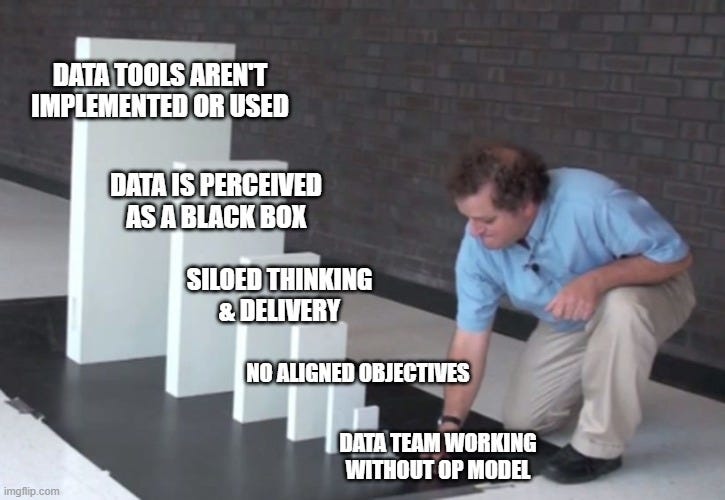Issue #13 - Defining the Data Operating Model
The real reason data projects fall flat
Read Time: 7 minutes
Most organisations hopefully have a strategy, a business model and an organisational structure (even if these things are thrown together or not well understood).
Well the next bit is delivering against those and defining how the organisation operates to achieve their business goals.
This is poorly done in most organisations, especially within data.
Why? Because it is extremely hard to do.
Role of the Data Operating Model
Before you read on, take a listen to this Driven by Data episode with Pete Youngs. He goes into detail about the importance of data operating models and what it means for an organisation to take it seriously. A couple of points I really like from this episode are:
The Data Operating Model is more important than a Data Strategy because you can’t deliver on your data strategy unless you operate efficiently, and that is the role of the operating model, to outline the ‘How’
An Operating Model needs to evolve with the data team, especially as the teams grow and the goals change. This is especially apparent with the advent of GenAI and new roles/ responsibilities that bring
An Operating Model is more than just a team structure and org chart. Unfortunately, companies don’t often go beyond those two elements (if they do those at all)
Hopefully, this helps underscore the importance of a data operating model within your data team and overall business system.
Data's Pain Points in Existing Operating Models
So what happens when you don’t have a functional data operating model?
Here are the most prevalent pain points I see in companies without a well-defined Data Operating Model and why they wreak havoc on companies:
Data Silos – Data teams are structured and operate in a silo, away from their business colleagues. With no official throughline or established ways of working, the outputs the data teams create have no impact on other teams and they end up being a black box that doesn’t deliver value
Short-term Thinking – Data teams become ticketing masters and are only there to execute on short-term asks for the business or leadership. Investment in data foundations (e.g., quality, modelling, engineering, governance, etc.) is non-existent because there is no operating model to help promote long-term scalability in delivery thinking
Business Context & Experience – Similar to silos, without the forums or collaboration across teams, data solutions lack business context and the experience of relevant stakeholders
Standardizing Processes – Without guiding principles and processes, every project is executed differently. This creates inefficiencies, frustration from all sides, and creates variability in delivery that ultimately hinders progress and desire to invest in data solutions
Implementation & Adoption – While dashboards or data solutions are developed, a lack of involvement by business stakeholders means they are unlikely to adopt these new tools. This issue underscores the principles of change management, which promotes appealing to individuals’ needs, focusing on buy-in, and celebrating little wins along the way
Lack of Measurement – Consistent measurement of progress or return is impossible. Data teams need to prove ROI to get investment, especially given their supporting role for other business functions, making this topic extremely important
Unclear Objectives – Without the structured ‘how’, people’s everyday objectives do not align with the overall strategy. For example, a McKinsey survey found that “28 per cent of managers report that their company does not cascade objectives and key results down to the team or individual level,” which is often due to a lack of operating model
Now, there is a lot there in terms of pain points.
And solving for this is hard. Like really really hard.
We won’t solve it all this week, but let’s try to define an approach to start thinking about how to solve for these elements.
Components of the Data Operating Model
The first step to solving is to understand. Given there is no concrete definition of what makes up a Data Operating Model (I looked, there is a lot of variability out there), I’ve defined what I think is the most important.
With that in mind, if I were to simplify the Data Operating Model, I would say:
It is a crucial framework/ approach that guides how the data & analytical function is organised and operates to deliver value within an organisation. This framework works across business domains and the data team(s) to provide a method for collaboration and coordination to support strategic objectives related to data.

To dive into more detail, there are three main levels of an Operating Model, each with multiple components that are worth briefly touching on:
What People Do – The actual day-to-day of the data and business teams, outlining what needs to get done and by whom
Roles & Responsibilities – What is the purpose of each role and why does it exist? What decisions does each individual make and what accountabilities might they have? Setting out the roles & responsibilities is crucial because it eliminates inefficiencies and sets direction between individuals and teams.
Structure of Delivery – The overarching structure and flow that guides individuals to get things done
Reporting Lines – What is the reporting structure for different roles and capabilities within the data team? How do they interact with other business domains & functions? Is there any cross-management of these teams to facilitate collaboration? An individual may know who they are reporting to, but in large organisations this can get lost and impact timelines, ownership and delivery.
Delivery Model – How are teams set up to deliver data initiatives? Should we take an agile or waterfall approach to delivery? What are the workflow processes to get things done and how do they alleviate existing pain points? Companies talk about working in an agile manner all the time, but the delivery model and workflows need to be set out to do it successfully (otherwise it is just a meaningless buzzword).
Workflow & Delivery Processes – What processes are in place to work with business stakeholders? What forums and principles will help promote collaboration and ensure communication between teams? In the end, processes need to exist to facilitate the operating model and set structure to the ways of working.
Oversight & Direction – The high-level principles, leadership and strategy that ensure the operating model is hitting on the right levels to deliver against the organisation’s goals
Program/ Org Leadership – Who is leading the data team? Who has ownership of the program and reports to the organisational executive team? The leadership needs to be accountably set to ensure the overall direction is clear and consistent
Data Strategy & Team Goals – What are we looking to achieve and how does it align with the organisational goals? For an Operating Model to work, you need to ensure the ‘what’ and ‘where’ is defined so the ‘how’ can execute against it
Governance Forums – How is the data program governed, both from a leadership and a day-to-day perspective? Forums need to exist to discuss issues, align on progress/ direction and determine the best path forward
Op Model Principles – What is the culture of how we work? How do we ensure collaboration and effectiveness in how we operate? Set guiding principles (kind of like values) for how teams should work together helps cut through inherent issues when working across teams
Performance Management – How do we measure the success of individual and team performance? What are the KPIs? What does a good ROI look like for our data initiatives? Measuring progress and performance often falls through the cracks, but implementing it within the operating model is one way to ensure teams pay attention to it.
It is worth briefly mentioning that many of these elements (and the operating model topic in general) overlap significantly with the data organisational structure, data team formation & training, and data leadership. All of these are other crucial components of driving alignment and data goals, but for purposes of brevity and completeness, they will be covered in other articles.
In the coming weeks, we will also look at an updated People, Process & Technology framework. Most examples of this methodology out there are outdated. It needs to include Data in the mix but requires a full article to do so (look for the PPT + Data perspective to drop in three weeks).
Next week we turn to Data Modelling. As described in last week's article, Data Modelling is one of the most underappreciated weapons in the data ecosystem, and businesses are ignoring it at their own peril. So, it’s time to approach it head on!
Thanks for the read! Comment below and share the newsletter/ issue if you think it is relevant! Feel free to also follow me on LinkedIn (very active) or Medium (not so active). See you amazing folks next week!





An operating model should include tools, standards and methodologies - arguably part of the Delivery Model and Workflow & Delivery Processes but should be mentioned explicitly. See https://www.linkedin.com/posts/antsims_the-information-factory-activity-6646993353349173249-C18o for details.
Very well Explained Daylan
Should the data operating model just be embedded and be w component of Target Operating Model is the company so it’s implemented along with it delivering the business vision. Regards, Shanmuk